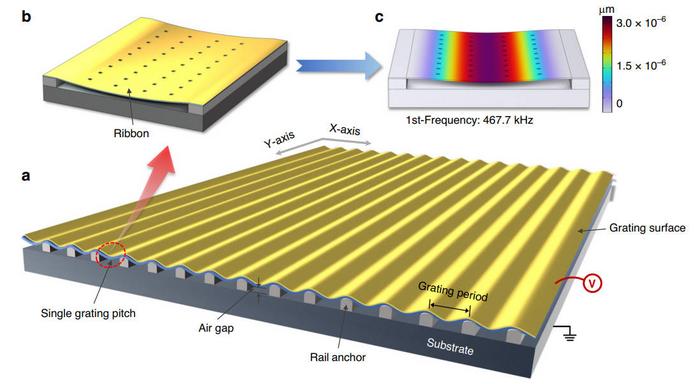A groundbreaking development in the field of photonics has emerged with the introduction of a new Microelectromechanical System (MEMS) grating modulator. This innovative device is designed to elevate the standards of optical communication and sensing technologies by enhancing both efficiency and scalability. Researchers at Northwestern Polytechnical University have skillfully integrated a tunable sinusoidal grating with broadside-constrained continuous ribbons, creating a modulator capable of achieving an impressive aperture size of 30 × 30 mm while facilitating high-speed modulation rates up to 250 kHz. These advancements mark a significant step forward in the quest for more efficient free-space optical communication and remote sensing capabilities.
Central to the success of this MEMS grating modulator is its remarkable optical efficiency, which reaches as high as 90%, coupled with a dynamic modulation contrast that exceeds 95%. Such performance metrics are poised to make the modulator exceptionally suitable for applications in free-space optical communication systems and advanced remote sensing tasks. The grating modulator’s unique dispersive characteristics further augment its usability, especially in wavelength sensing applications, making it an invaluable addition to spectrometers and hyperspectral imaging systems.
The backdrop for this innovation stems from the inherent limitations faced by traditional MEMS optical modulators. Most existing designs grapple with the intricate balance between aperture size, efficiency, and modulation speed. Traditional micromirror-based modulators are often plagued by low frequency performance, while their grating counterparts frequently encounter bending deformations that impede optical efficiency. These challenges have stymied the development of larger apertures that are essential for high-power applications, thereby highlighting a critical need for scalable, high-performance solutions.
Historically, the constraints imposed by mechanical designs have curbed the potential for advancement in optical communication systems. Previous iterations of MEMS optical modulators predominantly relied on mechanisms that could not support the increasing demands for larger apertures and higher modulation speeds. However, this latest design introduces a paradigm shift, effectively tackling the limitations that have hindered progress in the field and setting a new standard for future research and development.
The MEMS grating modulator’s genesis lies in an innovative design approach that employs broadside-constrained continuous ribbons. This unique architecture not only mitigates bending deformations but also empowers engineers to expand the aperture size without sacrificing the resonant frequency, which hovers around 460.0 kHz. Such a capability is crucial for maintaining the modulator’s functionality across a wide range of operational contexts, allowing it to remain resilient in the dynamic landscape of optical applications.
The ability to support modulation across a wide wavelength range—specifically from 635 to 1700 nm—enhances the versatility of this MEMS grating modulator significantly. This characteristic aligns with the growing demands for high-speed communication systems and applications in areas such as LiDAR and adaptive optics, where rapid response times are imperative. These advancements represent not merely incremental improvements but rather a leap towards revolutionizing optical communications and a spectrum of related technologies.
One of the key advocates for this revolutionary development, Dr. Yongqian Li, emphasized the transformative potential of the device: “By integrating a scalable aperture design with unrivaled optical efficiency, this modulator opens pathways to groundbreaking applications, ranging from LiDAR systems to sophisticated communication networks.” The elimination of traditional micromirrors also contributes to reducing complexity and cost, factors that are vital for widespread adoption in industry and research applications alike.
The expansive aperture and remarkable efficiency of the modulator not only render it suitable for long-distance free-space optical communication but also enhance its applicability in ensuring signal integrity over considerable distances. Its feasibility for rapid data transmission directly aligns with the needs of modern communication networks, where bandwidth demands continue to grow. As research on this technology progresses, future iterations may pave the way for multichannel capabilities or potential integrations with quantum communication systems.
In terms of practical applications, this MEMS device demonstrates a strong alignment with the demands of next-generation technologies. The significant improvements in performance metrics, coupled with its scalable design, position it as a frontrunner in the ongoing evolution of high-speed, energy-efficient optical systems. Furthermore, these innovations are poised to catalyze advancements in fields ranging from aerospace technologies to telecommunications, showcasing the versatility and impact of this emerging technology.
With the introduction of the MEMS grating modulator, researchers have not only addressed existing challenges within the field but have also set the stage for future explorations in optical engineering and communications. The ramifications of this technology could extend well beyond traditional applications, possibly influencing emerging fields that rely on photonic technologies for progress. As we look toward the future, the potential for this device to reshape how we think about and interact with optical systems remains profound.
In conclusion, the culmination of years of research and engineering has resulted in a formidable advancement in MEMS grating modulation technology. This development underscores the critical necessity for ongoing innovation in optical communications and reinforces the commitment of researchers around the world to push the boundaries of what is possible. The momentum created by such breakthroughs will undoubtedly pave the way for even more remarkable advancements in the realm of photonics, ultimately enabling systems that are faster, more efficient, and more capable than ever before.
Subject of Research:
Article Title: A MEMS grating modulator with a tunable sinusoidal grating for large-scale extendable apertures
News Publication Date: March 3, 2025
Web References: Link to the original research article
References: 10.1038/s41378-025-00894-7
Image Credits: Microsystems & Nanoengineering
Keywords
Nanotechnology, MEMS, Optical Communication, Photonics, Grating Modulator, High-Speed Modulation, Remote Sensing, Wavelength Sensing.
Tags: advanced remote sensing technologiesdynamic modulation contrastenergy-efficient photonics systemsfree-space optical communicationhigh-speed optical communication technologyhyperspectral imaging applicationslarge-aperture MEMS modulatorNorthwestern Polytechnical University researchoptical efficiency in MEMSscalable optical communication solutionstunable grating modulatorswavelength sensing innovations





